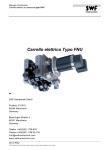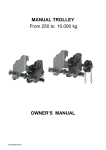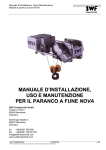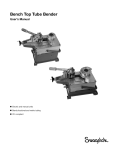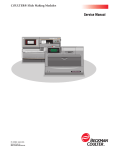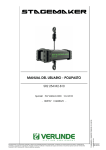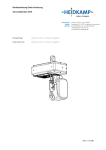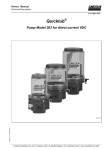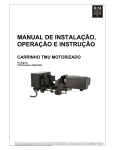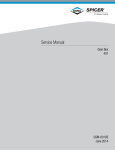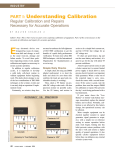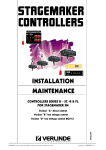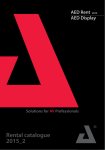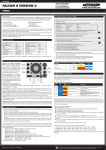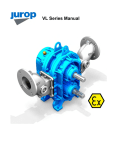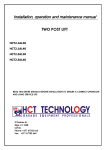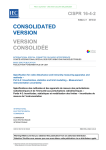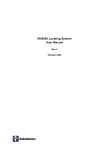Download What to do
Transcript
C.H.V INSTALLATION MAINTENANCE SPARE PARTS ANGLAIS VARIABLE SPEED ELECTRIC TROLLEY TYPE CHV VERLINDE reserves the right to alter or amend the above information without notice 04/02 VESEGBCHVA Table of contents Read the instructions supplied with the travelling machinery unit before installation and commissioning. Keep the instructions in a safe place for future reference. PART 1 OWNER'S MANUAL FOR NORMAL HEADROOM TROLLEY page 1 "EC" Declaration of conformity 1 2 What not to do 2 3 What to do 3 4 Guarantee 4 5 General 5-1 Acceptance of the material 5-2 Installation 5 5 6 Description - technical characteristics 6-1 6-2 6-3 6-4 Technical characteristics Environmental data Dimensions and weight Adjustment of flanges 7 7 7 8 7 Maintenance 9-1 9-2 9-3 9-4 9-5 Maintenance table Lubricants Spare parts replacement table Tightening torques Discarding the trolley 10 10 10 10 10 8 Illustrated catalogue 11-1 Electric trolley PART 2 11 OWNER'S MANUAL FOR TRAVELLING MACHINERY 9707 1 - EC Declaration of conformity VERNOUILLET France As defined by the EC directive relating to machinery 98/37/EEC. Annex II A Herewith, we declare that the product : Wire rope hoist Belt hoist Electric chain hoist Manual chain hoist Electric trolley Manual winch z z z z z z z z z z z z z z z Complies with the following provisions applying to it: - Machinery directive 98/37/EEC. - Directive 2006/95/CEE. - "EMC" Directive 89/336/EEC Applied harmonized standards, in particular: - EN 60204-32, - EN ISO 12100-1 and 12100-2 z z z z z z z z z z z z z z National regulations, standards and specifications: - order of March 1st 2004 - DIN 15400; DIN 15401, Quality system applied: - EN29001/ISO9001 z z z z z z z z z z z z z z z z z z z z z z z z z z z z Technical standards and specifications complied with, in particular: - FEM 9.511 "classification of the mechanisms". - FEM 9.661 "dimensions and quality of the drive and cable lifting block elements for mass-produced lifting devices". - EN 818 "chain quality, choice criteria and technical requirements". - FEM 9.683 "choice of motors". - FEM 9.755 "steps to be taken to determine the operating periods for massproduced motorized lifting mechanisms (S.W.P.)". - FEM 9.751 "Motorized lifting mechanism: safety" - FEM 9.901 "bases of design for the mass-produced lifting devices for travelling cranes equipped with mass-produced lifting devices". 2007/04 Bernard DELEFOSSE 2 - What not to do Never move or lift the machine by the electric cables. Do not set down the machine without having an adapted support, to avoid damaging the sensitive sides. Do not let the machine drop. Never modify the machine unless the constructor has studied and authorized the modification. Never modify the values and adjustments of the safety components, outside the limits provided for in the manual, or without the approval of the constructor. Never try to repair or intervene on the machine (welding...) without the authorization of the constructor or a trained maintenance agent. Never shunt the disconnect switches, electric switches, prevention or limitation equipment. Do not let an unqualified person use the machine. Do not let an unqualified person use the machine. Never lift more than the maximum working load indicated on the machine. Shocks or accidental collision of the load with objects can cause excess loads. Never remove the hook safety catches. Never block, adjust or remove the limit switches or stops to go further to the left or right than these allow. Never use the machine to extract, loosen, or pull sideways. Never use the machine to transport people. Do not touch the moving components. Do not operate the machine if your physical condition does not allow it. Never use the machine when in bad repair (wear, deformation...). Never use suspect spare parts or parts whose origin is not known. Never swing the load intentionally. Do not subject the machine to brutal shocks. Do not use the mechanical stops as a repetitive means of stopping. Never distract the operator while the machine is being operated. Never leave a suspended load hanging, if it is not necessary. Never swing the load intentionally. Never use the machine as an earth reference for welding. Do not use the machine for a purpose or in an area for which it is not intended. Do not expose the machine to an aggressive atmosphere (temperature, acidity... Refer to 6.2: Environmental data). Do not use the safety components as operation components. Do not use the controls needlessly (avoid inching - stop-start operation of the buttons). This can cause overheating and even damage to the machine. Never pull the load slantwise. Make sure that the machine is vertical to the load before lifting it. Do not use the machine with a power supply that is different to the one recommended (undervoltage or overvoltage, absence of phase...). Never transport a load with people nearby. Do not pass the machine, with or without a load, above a person. 9707 / 2 Never pull the load slantwise. 3 - What to do Handle the machine by its structure, or by the devices provided for this purpose, or in its original packing. Store the machine in its normal operating position (without load) away from aggressive atmospheres (dust, humidity...). Make sure that the machine is always clean and protected from corrosion (lubrication...). The machine should be installed by a technician with the necessary competence. Make sure that the machine attaching structure is rigid. Make sure that the safety rules are followed (harness, clearance of work areas, posting up of instructions to be followed in the area...). Neutralize the power sources. Comply with the distance between the trolley and the raceway. Connect the feed cable directly to the supply terminal board in the electric box. Make sure that the machine is always clean. Set up an inspection program and record all of the maintenance operation for the machines, in particular: the brake, limit switches, fastening beam... Replace any element that is worn or may be defective. The machine should be maintained regularly, following the instructions in this manual. Check the operation and adjustment of the safety components (brake, travel limit...) in conformity with the user manual. Regularly check the machine. If a deformation or unusual wear is noted, the parts must be changed. Check that the assembly elements are correctly tightened. Check that the strands of the steel cable supporting the control box fulfill their functions correctly. The electric cable of the box is not a handling cable. The components should only be replaced by original parts that are compatible with the type of machine. Before operation, check that the load is correctly fastened and installed. Make sure that the load is correctly balanced before moving it. Pay attention to the center of gravity of the load to be moved. Material used outdoors should be protected as well as possible against bad weather conditions. If manually moving the machine, push the load. When moving the load, make sure that it is sufficiently raised and distant from the surrounding machines and other objects so as to avoid all obstacles during operation. If manually moving the machine, push the load. The prevention instructions to be carried out during the different operations should be well known. Use the material under normal working conditions (ambient temperature, atmosphere...). Material used outdoors should be protected as well as possible against bad weather conditions. Notify the necessary people after a dangerous operation or if the machine seems problematic (abnormal noise, abnormal behavior...). 9707 / 3 4 - Guarantee Our electric trolleys are guaranteed for two years from the date of delivery. If for a reason outside the control of the vendor, the delivery is delayed, the time lag cannot exceed three months. If the use (installation) of the machine is delayed, the corresponding extension of the guarantee (a single extension limited to three months) must be requested, and written confirmation obtained. The vendor undertakes to eliminate all operating errors originating from the concept, the execution, the components or the materials themselves. The guarantee does not cover normal wear*, nor the failures resulting from lack of regular and periodic maintenance. It does not cover damage due to a lack of supervision, to false operation or to a bad utilization of the machines, particularly due to overload conditions, slantwise drawing, undervoltage or overvoltage or a connection error. The guarantee does not apply when there is disassembly, modification or replacement of parts (mechanical or electrical) by an unauthorized party or without our prior agreement. The guarantee only applies for original, factory-installed spare parts. For the duration of the guarantee, the vendor undertakes to replace or repair, free of charge, the parts that are acknowledged to be damaged following examination by a qualified and authorized technical service. The guarantee excludes any other services or indemnities. The repairs covered by the guarantee are carried out, as a rule, in the workshops of the vendor or authorized agent. When servicing of the equipment is done outside these workshops, the labor costs for disassembly or assembly of these parts are borne by the vendor when these are done exclusively by his staff or by an authorized agent. The replaced parts become the property of the vendor and must be returned to the vendor at his expense. For components of a relative particular importance that are not manufactured by the vendor and which carry the brand name of specialized manufacturers, the manufacturer’s guarantee (which can vary according to the manufacturer) is applicable. * The guarantee does not apply for expendable parts defined by the manufacturer: - Brake disk - Brushes - Drive pinion - Rubber buffer - Rollers - Guides 9707 / 4 5 - General 5 - General 5-1 Acceptance of the material Carry out a visual inspection of the packing to ensure that it is intact. If it is not, issue the appropriate notifications. Check that the trolley corresponds to your order. 5-2 Installation The service life of a trolley depends on the way in which it is installed. It is essential that the instructions in this manual are followed carefully for the installation, use, and maintenance of your machine. Any use contrary to our instructions may be dangerous. In this case, the manufacturer will not accept any liability. Do not use the machine without having read and understood the whole of the instruction manual. Always keep the manual close to the machine, available to the operator and to the person responsible for maintenance. Make sure that the safety rules are followed (harness, clearance of work area, posting of instructions to be followed in the work area, etc.). The trolley can be adapted to all runaway profiles. Couple or hook on the hoist after installation of the trolley. CAUTION Check the width of the runaway rail and adapt the spacing of the flanges of the trolley as indicated in the tables Make sure: * That the profile is secured. * That the profile is suitable to the loads to be supported. * That the dimensions are compatible with the trolley which is to be installed. * That the electrical characteristics of the mains network conform to those of the motor. Carry out: 1 - Disassembly of the trolley * Remove the side plate on the counterweight side * Position the trolley on the beam * Refit the side plate. Check that all the nuts are correctly tightened. (see 7-4: Tightening torques) 2 - Without disassembly of the trolley: - Instal the trolley on the profile, by the end * Fit the travel limit stops (not provided) at the end of the runway. Check that all the nuts are correctly tightened. (see 7-4: Tightening torques) On the curved profiles, the driving wheels should for preference be positioned on the outside of the curve. Y + Z = 4 mm MAXI VERY IMPORTANT! The total play on the same side, between the driving rollers and the edge of the profile, must not exceed 4 mm. 0402/5 Suspension with VL1-VL5-VL10-models 1 fall Suspension with VL16-VL20-VL25 2 falls 1 fall 0215/6 2 falls 6 - Description - technical characteristics The trolley which you have just purchased should only be used with the nominal load indicated on the rating plate. The length of its service life depends on the demands placed on it, the average operating time, the number of start-ups and its maintenance 6-1 Technical characteristics The NHT can be used for loads from 250 kg up to 5000 kg with all our electrical chain hoists. It can be drived with a inverter drive unit or a dual or single speed unit. It can drive on straight trucks or curved trucks with the following radius: <1000kg ≤2000kg ≤3200kg ≤5000kg 2m 2m 2m no radius 6-2 Environmental data • • Ambient temperature: Protection degree: -20°C to +40°C IP55 as standard Impact on the environment: • Sound level: 70 decibels at 1 metre Rating plate 6-3 Dimensions See the dimension sheet 0215 /7 6-4 Adjustment of the flanges C1 ≤1000 C2 ≤2000 C3 ≤3200 C5 ≤5000 4 64 66 72 73 74 81 82 89 90 91 98 100 106 108 110 113 118 119 120 125 126 131 133 135 137 140 143 146 147 149 150 155 158 160 166 168 170 178 180 185 186 188 190 198 200 206 210 215 218 220 226 240 248 260 268 280 288 300 302 303 304 305 306 307 308 309 310 225 270 320 370 430 4 6 14 16 18 22 24 30 30 32 36 40 0 2 3 8 9 11 12 16 18 20 22 24 26 30 32 36 38 40 46 0 4 6 12 13 14 24 25 30 32 34 36 44 46 4 7 12 14 18 24 37 44 0 7 19 26 38 42 43 43 44 44 44 0 2 2 0 2 4 4 6 6 8 8 10 10 12 12 0 0 1 2 3 3 4 4 4 6 6 8 8 10 10 12 12 12 12 0 0 2 4 4 4 8 8 10 10 10 12 14 14 0 2 4 4 6 8 12 14 0 2 6 8 12 14 14 14 14 14 14 0 0 0 2 0 1 2 0 2 0 3 0 1 0 2 0 1 0 1 0 1 0 2 3 1 2 0 1 0 1 0 1 2 3 0 2 0 0 1 2 0 1 0 1 2 0 1 2 2 1 0 2 0 0 1 2 0 1 1 2 2 0 1 1 2 2 2 0 1 1 260 325 390 460 0 2 8 10 10 17 17 25 25 28 34 36 42 44 46 48 54 54 56 60 62 2 6 8 8 12 14 17 20 20 22 26 30 32 38 40 42 50 52 56 58 60 62 6 8 14 17 22 26 28 34 48 56 4 12 24 32 44 46 48 48 50 50 52 52 54 54 0 0 2 2 2 4 4 6 6 6 8 8 10 10 10 12 12 12 14 14 14 0 0 2 2 2 2 4 4 4 4 6 6 8 8 10 10 12 12 14 14 14 14 0 2 2 4 4 6 6 8 12 14 0 2 6 8 10 10 12 12 12 12 12 12 12 12 0 1 0 1 1 1 1 1 1 2 1 2 1 2 3 0 3 3 0 2 3 1 3 0 0 2 3 1 2 2 3 1 3 0 3 0 1 1 2 0 1 2 3 3 0 3 1 3 1 2 1 0 0 2 2 0 0 2 3 0 0 1 1 2 2 3 3 0215 / 8 305 355 415 480 3 8 11 11 19 198 27 27 30 32 38 38 40 46 46 51 54 54 56 3 6 8 8 11 11 16 19 22 227 30 32 40 43 46 48 51 51 3 3 11 14 19 22 24 30 43 51 6 14 27 35 46 48 48 51 51 51 54 54 54 56 0 2 2 2 4 4 6 6 6 8 8 8 10 10 10 12 12 12 14 0 0 2 2 2 2 4 4 4 6 6 8 10 10 10 12 12 12 0 0 2 2 4 4 6 6 10 12 0 2 6 8 10 12 12 12 12 12 12 12 12 14 1 0 1 1 1 1 1 1 2 0 2 2 0 2 2 1 2 2 0 1 2 0 0 1 1 0 1 2 1 2 0 0 1 2 0 1 1 1 1 1 2 1 2 0 2 1 1 2 2 1 1 2 0 0 1 1 1 2 2 2 0 309 339 381 429 488 6 12 14,5 14,5 20,5 24 30 32,5 35 6 12 12 14,5 18 20,5 24 26,5 30 30 32,5 36 42 42 42 44,5 6 8,5 12 17 20,5 20,5 30 32,5 36 38,5 38,5 42 49,5 50,5 6 12 18 20,5 23 30 44,5 52 5 12 24 32,5 44,5 47 47 48 50,5 50,5 53 53 53 54 1 2 2 2 3 4 5 5 5 1 2 2 2 3 3 4 4 5 5 5 6 7 7 7 7 1 1 2 2 3 3 5 5 6 6 6 7 7 8 1 2 3 3 3 5 7 7 0 2 4 5 7 7 7 8 8 8 8 8 8 9 0 0 1 1 1 0 0 1 2 0 0 0 1 0 1 0 1 0 0 1 0 0 0 0 1 0 1 0 2 1 1 0 1 0 1 1 0 3 1 0 0 0 1 2 0 1 4 2 0 0 1 1 2 2 0 1 1 2 2 2 0 IMPORTANT NOTICE Minimum beam height Safety washer CAUTION ! In all cases, allow as a minimum for one or more washers on the outside of the flange, underneath the bolt. 0215 /9 7 - Maintenance 7-1 Maintenance table Check Checking of the screw tightening torques and checking for signs of corrosion Measurement of the diameter of the roller raceway band Condition of the roller drive pinion Interval Qualification of the client's personnel Annually Qualified mechanic Annually Annually Operator Operator CAUTION! These intervals should be shortened if the machine is used a lot, if it is used with maximum loads or in difficult ambient conditions. 7-2 Lubricants Lubrication point Roller drive pinion Specifications KP2K-25 grease (DIN 51502) Soap-based lithium + MoS 2 Approx. melting point + 180°C Worked penetration 355 - 385°C Operating temperature - 25°C à + 130°C Bearing (*) Possible brands Tribol: Molub Alloy multipurpose grease Aral: Aral P 64037 grease Aralub PMD0 BP: Multi-purpose grease L 21 M Esso: Multi-purpose grease M Mobil: Mobilgrease Special Shell: Shell Retinax EP Texaco: Molytex grease EP 2 Fuchs: Renolit FLM0 Quantity As necessary (*) 0.02 L 7-3 Spare parts replacement table After a long period of non-use or during a routine checks, check the operation and adjustment of the safety items (brake, end stops...). If there is a possibly defective element, deformation or abnormal wear, the parts must be changed. CAUTION! Disconnect the power supply before replacing any parts. Spare part Roller drive pinion Gear reducer assembly Brake cap sealing Other sealings Rubber buffer To be replaced by Qualification of the personnel Authorized manufacturer personnel Authorized manufacturer personnel Authorized manufacturer personnel Authorized manufacturer personnel Authorized manufacturer personnel Qualified mechanic Qualified mechanic Qualified mechanic Qualified mechanic Qualified mechanic Once a part has been replaced, check the operation of the trolley (refer to 5.2: Installation). 7-4 Tightening torques (daNm) Normal screws Self-tapping screws Suspension part screws "class 8.8" Gearmotor assembly attaching screws M5 6 5 M6 10 8 M8 24 20 M10 48 40 M12 83 72 83 24 7-5 Discarding the trolley Once the trolley has been used for the FEM class duration, all of the components must be checked by an authorized agent or by the manufacturer. The trolley should no longer be used, unless agreement is obtained from the authorized agent or the manufacturer. Remove all greases from the trolley before discarding it. 0215 / 10 8 - Illustrated catalogue 8-1 Electric trolley 6 19 3 4 22 5 1 28 2 1 28b 28a Fond 28c 15 Fond 14 23 13 25 7 F 14 13 9 10 17 16 14 12 16 15 24 26 27 26a 0215 / 11 11 Rep. 1 2 3 6 7 7 7 7 7 7 7 7 7 7 7 7 7 7 7 7 7 7 7 9 9 9 9 9 9 9 9 10 10 10 10 11 11 11 11 12 13 14 15 16 17 19 22 23 24 25 26 26a 27 28 28 28a 28a 28b 28b 28c Qty. 2 2 2 4 2 2 2 2 2 2 2 2 2 2 2 2 2 2 2 2 2 2 2 4 4 4 4 4 4 4 4 1 2 4 1 1 1 1 1 1 1 4 1 1 1 1 1 1 1 1 1 2 <1000kg 2141000 558909 558908 400076 2142553 2142554 2142555 2142556 2142557 2142558 832110 832111 831523 831575 558940 558943 100051 558946 400762 831598 52299089 830203 558907 2222002 558993 601801 7541312D 601806 601807 602910 602911 558997 558999 7215453J <2000kg <3200kg 2151000 2161000 558919 558929 558918 558928 830860 830201 2152563 2152564 2152565 2152566 2162563 2162564 2162565 2162566 832112 832113 400773 832114 831540 831530 831576 831577 558941 558942 558944 558945 400078 400081 558947 558947 832110 832110 831596 831596 52299087 52299087 830203 830203 558917 2222003 2277020 558993 558993 601801 601801 7541312D 7541312D (7661106Q+5531802D) 601806 601806 601807 601807 602910 602910 602911 602911 558997 558997 558999 558999 7215453J 7215453J <5000kg 2181000 558949 558948 400078 2182553 2182554 2182555 2182556 2182557 8584206 8584225 8004234 8004208 52299087 830203 2182000 558993 601801 7541312D 601806 601807 602910 602911 558997 558999 7215453J 0215 / 12 Désignations Side plate Driving wheel with bearings 2+4+5 Idle wheel with bearings 3+4+5 Circlips ext. Tension rod for the wide beam = 55-100 Tension rod for the wide beam = 106-150 Tension rod for the wide beam = 155-200 Tension rod for the wide beam = 206-248 Tension rod for the wide beam = 260-307 Tension rod for the wide beam = 308-310 Tension rod for the wide beam = 64-126 Tension rod for the wide beam = 131-190 Tension rod for the wide beam = 198-248 Tension rod for the wide beam = 260-310 Tension rod for the wide beam = 82-137 Tension rod for the wide beam = 140-190 Tension rod for the wide beam = 198-248 Tension rod for the wide beam = 260-310 Tension rod for the wide beam = 82-110 Tension rod for the wide beam = 113-150 Tension rod for the wide beam = 155-200 Tension rod for the wide beam = 206-248 Tension rod for the wide beam = 260-310 Washers M20 ep = 3mm Washers M20 ep = 2mm Washers M24 ep = 4mm Washers M24 ep = 2mm Washers M30 ep = 4mm Washers M30 ep = 3mm Washers M36 ep = 6mm Washers M36 ep = 2,5mm Nut H M20 Nut H M24 Nut H M30 Nut H M36 PAL nut M20 PAL nut M24 PAL nut M30 PAL nut M36 Coupling part Positionning tube Circlips Suspension axle Washer Nylstop nut Gearmotor assembly 48vac CHC Screw Counterweight Adaptation part (perp) Bumper Complete limit switch Limit switch Earthing brush (brush + support) Line drive ironwork 235 mm Line drive ironwork 435 mm Line drive ironwork 170 mm Line drive ironwork 400 mm Ram for line drive ironwork 235 mm Ram for line drive ironwork 435 mm Screw CHC 8x16 PART 2 OWNER'S MANUAL FOR TRAVELLING MACHINERY 0402/14 Table of contents Read the instructions supplied with the travelling machinery unit before installation and commissioning. Keep the instructions in a safe place for future reference. PART 2 OWNER'S MANUAL FOR TRAVELLING MACHINERY Pages 1 2 3 4 5 6 7 8 Instructions ..................................................................................................................................................16 1.1 Symbols and abbreviations ............................................................................. Erreur! Signet non défini. Safety instructions.......................................................................................................................................17 2.1 Safety instructions for preparing to install the travelling machinery unit.................................................17 2.2 Safety instructions for installing and operating the travelling machinery unit .........................................17 2.3 Safety instructions for servicing the travelling machinery unit ................................................................17 Travelling machinery ...................................................................................................................................18 3.1 General ...................................................................................................................................................18 3.2 Mounting position of the machinery ........................................................................................................18 3.3 Assembling the travelling machinery unit................................................................................................18 3.4 Start-up procedure ..................................................................................................................................19 3.5 Inspection and service procedure for travelling machinery.....................................................................19 3.6 Detaching and replacing the travelling machinery unit ...........................................................................19 Compact-brake.............................................................................................................................................20 4.1 Adjustment of Compact-brake air gap ....................................................................................................20 4.2 Removing the Compact-brake ................................................................................................................20 Frequency converter for travel...................................................................................................................21 5.1 Inspection and servicing of the frequency converter for travel ...............................................................21 Electrical diagram Inspection and servicing intervals.............................................................................................................22 Spare parts………… ………………………………………………………………………………...……………..11 0402/15 1 Instructions The instructions needed for the safe and effective installation, operation and maintenance of the travelling machinery are included in the delivery. The travelling machinery itself is also provided with labels and markings. The instructions are issued on paper. Read all the instructions supplied before starting to install and commission the travelling machinery unit. Keep the instructions in a safe place for future reference. 0402/16 2 Safety instructions 2.1 Safety instructions for preparing to install the travelling machinery unit Follow these instructions when preparing to install the travelling machinery unit: • Ensure that installation personnel are professionally competent, professionally qualified and are provided with adequate instructions for carrying out the installation work. • Check for any dimensional nonconformance in drawings, instructions, parts and structural measurements. • Beware of other moving machinery in the installation and servicing site, such as machines, other cranes and automatic doors. The installation area must be arranged so that operation of other equipment does not endanger installation work (or vice versa). • Prevent unauthorized persons and bystanders from walking on or below the work site. 2.2 Safety instructions for installing and operating the travelling machinery unit Follow these instructions when installing the travelling machinery unit: • Use proper safety equipment to prevent objects from falling when working in high places. • Ensure that machinery and equipment cannot start up accidentally and cannot move during installation and servicing. • Keep installation and servicing locations, and walkways leading to them, clean and tidy. Follow these instructions when operating the travelling machinery unit: • The useful lifetime of a travelling machinery unit depends very much on whether the machinery is correctly used or not. Use of the machinery for other than the duty group classification for which it was designed changes its useful lifetime. • During travel motion, ensure that the moving parts do not collide with objects or people. • If excessive forces are directed to travelling machinery unit, for example due to collision, check the tightness of the fixing bolts and the operation of motor, brake and gear. Check the travelling motions and pay a special attention to any abnormal noises indicating damage in transmission train. • If defects have been noticed in the travelling machinery unit, carry out the necessary inspections and servicing. Ensure that the travelling machinery unit operates properly before you start to use it again. • Avoid short, jerky motions. Unnecessary short starts cause the motor to overheat quickly. • Do not change the size of fuses. A qualified electrician should carry out all electrical work. 2.3 Safety instructions for servicing the travelling machinery unit Follow these instructions when servicing the travelling machinery unit: • Carry out regular inspections and preventive maintenance in compliance with the instructions. Keep a record of inspections and servicing. Regular servicing and inspection procedures are necessary for the safe and efficient operation of the travelling machinery unit. In uncertain or unusual cases, contact the supplier of the travelling machinery unit. • Pay special attention to the operation of the brake. It is essential that safety devices work correctly and are in full operating order because they safeguard against human error. • Use trained servicing personnel authorized by the manufacturer of the travelling machinery unit for servicing the travelling machinery unit. The person servicing the travelling machinery unit must be competent for the task and must be familiar with the servicing and inspection instructions. • Use only genuine spare parts approved by the manufacturer of the travelling machinery unit. • Any modifications or additions made to the travelling machinery unit’s structures or performance values must first be discussed with the supplier of the travelling machinery unit. 0402/17 3 Travelling machinery 1. 2. 3. 4. 5. 3.1 Gear/motor unit Brake friction discs Brake disc Aluminium ring Adjustment nut 6. 7. 8. 9. 10. Motor cover Electric box Frequency converter Connecting cable Fixing screws General The travelling machinery units are designed to perform the travelling movement of the crane or the hoisting trolley either as a single unit or as several units. Any other kind of use (e.g. hoisting motion) is forbidden. Machinery is suitable for both indoor and outdoor use. Please note possible restrictions for special environments (e.g. galvanization plants). 3.2 Mounting position of the machinery Travelling machinery unit is to be mounted so that the electric box is on the side of the motor and connecting cables are pointing downwards (see picture above). Different mounting position than pictured above will reduce the cooling of electric box. As a result, inverter may overheat and damage. 3.3 Assembling the travelling machinery unit Ensure that the working area is safe and the machine cannot be started accidentally when making the assembly work. Be sure to switch off securely the electric power from the device to avoid the electric shock and sudden start. • Align the machinery unit with the teeth of the driving wheel and push it against the face surface. 0402/18 • Rotate the machinery to a correct angle to align the fixing bolt holes. Note that the motor brake prevents the free rotation. For enabling the rotation release the brake (see the instructions of the motor) or jack the wheel up from the rail. • Turn the fixing bolts loosely to their places not forgetting the washers. • If the wheel was jacked up, lower it down before tightening the fixing bolts. Wheel must lie on the track when the screws are tightened to ensure that no excessive loads are directed towards the secondary shaft. • • 3.4 Tighten the fixing bolts to a torque. Recommended tightening torque for M8 bolt is 23 Nm. Connect the power supply plug to the motor. Start-up procedure • Make sure that the conditions at the operating site correspond to the operating conditions for which the travelling machinery is designed (including indoor/outdoor use, ambient temperature/radiance temperature, wind, dust, splashing, snow, water, handling hazardous materials, fire risk, etc). • Check that the supply voltage and frequency are suitable for the travelling machinery. • Check the correct direction of rotation. Verify that the direction corresponds to the control signal. In multimotor systems check that all the units function correctly in series. If any of the motors runs incorrectly the electric connections have to be checked and corrected by a professional electrician and/or authorized serviceman. Refer to the electric instructions and electric wiring diagram for further measures. Be prepared for equipment moving in the wrong direction when testing. • Check the function of the brake. The brake is factory set and normally ready to be taken into use. • Make an audible check of the running sound of the machinery. Very loud growling sound indicates an incorrect connection of the motor. This must be corrected immediately. A regular distinct clatter sound is an indication of a broken bearing and this must be corrected by an authorized serviceman. • Check the vibration during the run by hand. The cause of the excessive vibration must be identified. If the machinery causes the fault it must be checked by an authorized serviceman. • Check the running temperature during the long-term operation. The temperature rise of the F-class motor must not exceed 100°C. If the temperature rise is too high the motor may run faulty, the cooling does not function correctly or the motor is overloaded. The reason must be identified and corrected by an authorized serviceman. • Ensure that the test drive and commissioning inspection have been properly carried out and that the handover log has been properly completed. • Ensure that any safety devices bypassed for testing purposes are restored to full operational status. 3.5 Inspection and service procedure for travelling machinery Carry out the following inspections and servicing procedures at regular intervals. See section 'Inspection and servicing intervals' for the period of time between inspections and services. • Check the tightness of the fixing bolts. • Check the travelling motion: acceleration and deceleration. • Check the brake for wear of friction linings. If necessary, clean the brake and replace the friction linings. • Check the air gap and adjust if necessary. Refer to the motor instructions section for further measure. • Check that the frequency converter operates correctly. • If travelling machinery unit is equipped with gear reducer, check it for leakage. • Gears are lifetime lubricated with semi-fluid grease and there is no need to add or change the lubricant in normal conditions. 3.6 Detaching and replacing the travelling machinery unit Ensure that the working area is safe and the machine cannot be started accidentally when making the assembly work. Be sure to switch off securely the electric power from the device to avoid the electric shock and sudden start. • Disconnect the power supply plug from the motor. • Open the fixing bolts of the machinery and remove the bolts. • Pull out the machinery from the driving wheel. • Assemble the new machinery unit according to the instructions in section ‘Assembling the travelling machinery unit’. 0402/19 4 Compact-brake 4.1 • • • • • 4.2 • • • • • • • Adjustment of Compact-brake air gap Ensure there is no danger of live voltage. Remove the power supply plug for the travelling machinery. Open the motor cover. Push the brake disc and measure the air gap between the adjustment nut and aluminium ring. The air gap have to be 0.2 - 0.3 mm. If needed adjust the air gap using the adjustment nut. Fasten the motor cover and the power supply plug. Removing the Compact-brake Ensure there is no danger of live voltage. Remove the power supply plug for the travelling machinery. Open the motor cover. Unscrew the adjustment nut for the brake air gap. Extract the brake parts. If the thickness of the friction material is less than 5 mm, replace all the brake parts. Re-assemble in the reverse sequence. Adjust the brake air gap. Refer to the section 'Adjustment of Compact-brake air gap’. 0402/20 5 Frequency converter for travel X1 X2 X1 c_fcmo1c 1. Connector, X1 Control (and power) connector, X2 Power connector 2. Signal lamp for malfunction (red) 3. Signal lamp for operating status (green) 4. Parameter switches The electric box contains a frequency converter that controls the speed of rotation of the travelling motor and the brake. The frequency converter changes the speed of rotation of the travelling motor according to the commands given by the operator. The frequency converter has a signal lamp (3) indicating its operating status and a signal lamp (2) to indicate a malfunction. When the operating status signal lamp (3) is lit, the frequency converter is operating. When the operating status signal lamp (3) is flashing, a malfunction has been active but operation of the machinery is still possible. When the malfunction signal lamp (2) is lit, a malfunction has occurred that prevents operation of the travelling machinery. The settings for the frequency converter have been pre-set at the factory with the parameter switches (4). All connections to the frequency converter are made via connector (1). 5.1 Inspection and servicing of the frequency converter for travel The frequency converter contains live parts at voltages that could cause death by electric shock. Wait at least five minutes after disconnecting the electricity supply before carrying out any servicing procedures on the frequency converter. Carry out the following inspections and servicing procedures at regular intervals. See the instruction 'Inspection and servicing intervals' for the allowable period of time between inspections and services. - Test the correct operation of the frequency converter by driving the trolley. - Check the signal lamp (3) for operational status and the signal lamp (2) for malfunction. If the malfunction signal lamp (2) of the frequency converter is lit, contact a service organization authorized by the manufacturer. 0402/21 6 Electrical diagram 0402/22 7 Inspection and servicing intervals The inspection and servicing interval for a travelling machinery unit is 12 calendar months. However, travelling machinery unit can be mounted on a crane or a hoist, which inspection and servicing intervals are defined by Safe Working Periods (SWPs). In these cases the servicing procedure must always be carried out at the end of the servicing period (SWP%) of a crane or a hoist, or by the end of the stated number of calendar months, whichever comes first. Travelling machinery units in intermittent duty should be inspected before being used. For ensuring the usability of the travelling machinery unit the servicing intervals can be shorten. Servicing procedure may only be carried out by a serviceman authorized by the travelling machinery unit manufacturer or service personnel adequately trained by the manufacturer. If any defects or abnormalities are observed, they must be investigated and corrective action must be taken in accordance with the instructions. 0402/23 8 Spare parts 1 2 4 3 Code SPECIFICATION 1 52296293 M06-001V 2 3 4 4 5 52300292 52300291 52300287 52300288 52297959 M06-008V M06-007V M06-003V M06-004V CCGCELCP-04 POS DESCRIPTION 8.1.1 Brake repair set Sealing set Terminal box Inverter: 48V + FILTER Inverter: 115V + FILTER Connection cable 0402/24 2, Boulevard de l’industrie B.P. 59 - 28501 Vernouillet Cedex FRANCE Tel. (33) 02 37 38 95 95 Fax. (33) 02 37 38 95 99 Internet : www.verlinde.com E-mail : [email protected]


























